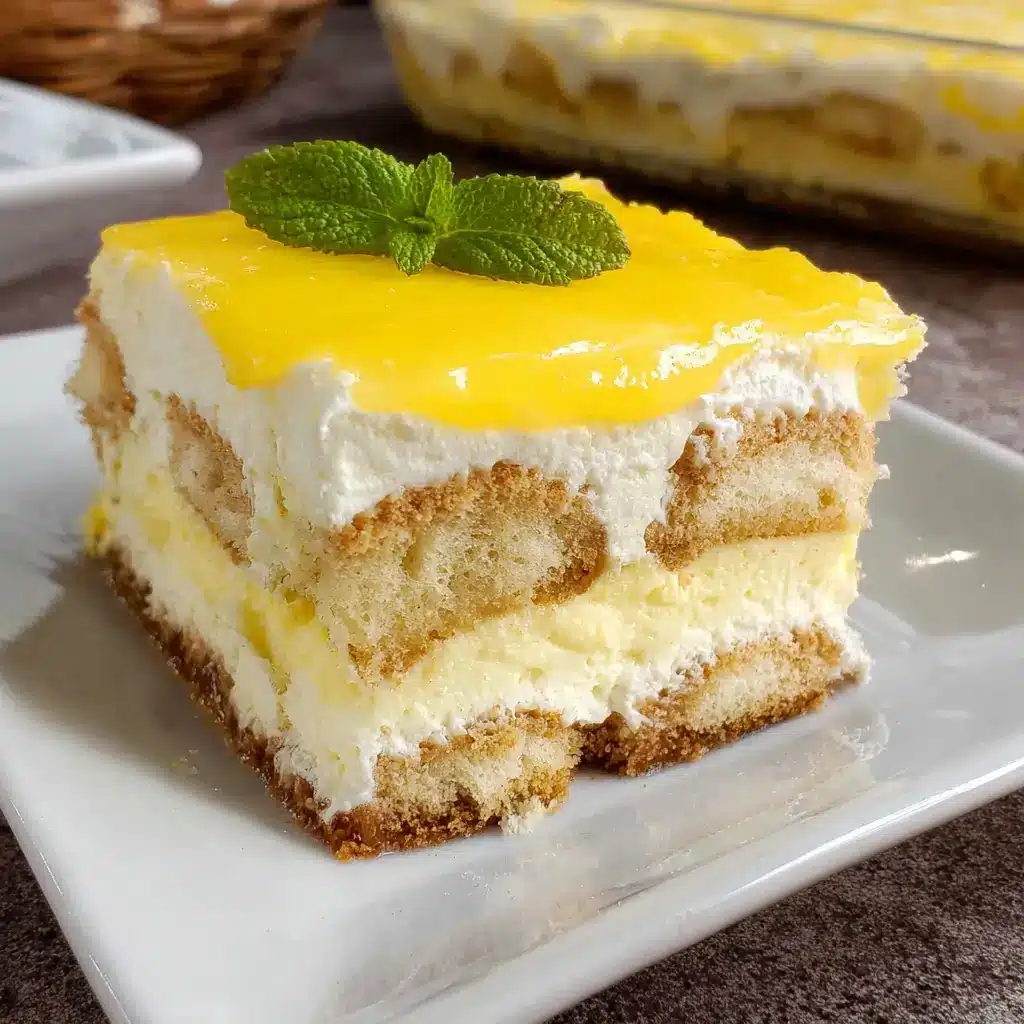Of all the desserts that have graced my family’s table, none capture the essence of a sun-drenched Italian summer quite like this Limoncello Tiramisu. I first made it on a whim, searching for a lighter, brighter alternative to the classic coffee-and-cocoa-dusted tiramisu for a warm-weather gathering. The traditional version, while beloved, can feel a bit heavy on a balmy evening. I wanted sunshine in a dish, a dessert that was both luxuriously creamy and exhilaratingly fresh. The result was nothing short of a revelation. The first time I served it, a hush fell over the table, followed by a chorus of “wows.” My husband, a die-hard traditionalist, declared it his new favorite. My kids, who usually wrinkle their noses at anything “fancy,” were scraping their plates and asking for seconds. It has since become our signature celebration dessert, requested for birthdays, anniversaries, and any excuse we can find to assemble it. The magic lies in the balance: the rich, velvety mascarpone cream, the zesty punch of fresh lemon, and the sweet, fragrant kiss of Limoncello liqueur soaking into the tender ladyfingers. It’s a dessert that feels both incredibly elegant and joyfully simple, a true testament to the power of quality ingredients and a little bit of love.
The Ultimate Limoncello Tiramisu: A Taste of the Amalfi Coast
This recipe is more than just a set of instructions; it’s a guide to creating a show-stopping dessert that will transport you straight to a cliffside villa overlooking the sparkling Mediterranean. We will delve into every detail, from selecting the right ingredients to the art of layering, ensuring your final creation is as perfect in structure as it is in flavor. Forget coffee; this tiramisu is a vibrant, citrus-infused dream.
Ingredients for a Perfect Limoncello Tiramisu
The quality of your ingredients will directly impact the final flavor and texture of your dessert. Where possible, opt for fresh, high-quality components. This recipe is designed to serve 8-10 people and fits perfectly in a 9×13 inch (23×33 cm) baking dish.
For the Lemon-Limoncello Syrup:
- Water: 1 cup (240 ml)
- Granulated Sugar: ½ cup (100g)
- Limoncello Liqueur: ¾ cup (180 ml), good quality
- Fresh Lemon Juice: ¼ cup (60 ml), from about 1 large lemon
For the Mascarpone Cream:
- Large Egg Yolks: 6 (use fresh, high-quality eggs; we will be tempering them for safety)
- Granulated Sugar: ¾ cup (150g), divided
- Mascarpone Cheese: 16 oz (450g), full-fat, at room temperature
- Heavy Whipping Cream: 2 cups (480 ml), very cold
- Limoncello Liqueur: ¼ cup (60 ml)
- Lemon Zest: From 2 large organic lemons (be sure to wash them well)
- Vanilla Extract: 1 teaspoon
For Assembly:
- Ladyfingers (Savoiardi): Approximately 40-48 cookies (two 7oz/200g packages), depending on your dish size. Use the firm, crisp Italian variety.
For Garnish (Optional but Recommended):
- White Chocolate: 3 oz (85g), finely shaved or curled
- Fresh Mint Leaves: A handful
- Additional Lemon Zest or Candied Lemon Peel
Step-by-Step Instructions for a Flawless Dessert
Patience and technique are the secrets to a tiramisu that is light, airy, and holds its shape beautifully. Follow these steps carefully for guaranteed success.
Part 1: Prepare the Lemon-Limoncello Soaking Syrup
This syrup is the heart of the dessert, infusing the ladyfingers with a vibrant, citrusy flavor.
- Create the Simple Syrup: In a small saucepan, combine the 1 cup of water and ½ cup of granulated sugar. Place over medium heat.
- Dissolve and Cool: Stir continuously until the sugar has completely dissolved. You don’t need to bring it to a rolling boil; just ensure it’s fully incorporated. Once dissolved, remove the saucepan from the heat and let the syrup cool completely to room temperature. This is a crucial step—adding liqueur to hot syrup will cause the alcohol to evaporate too quickly.
- Infuse with Flavor: Once the syrup has cooled, stir in the ¾ cup of Limoncello and ¼ cup of fresh lemon juice. Pour this mixture into a shallow dish (a pie plate works well) that is wide enough for dipping the ladyfingers. Set aside.
Part 2: Craft the Luxurious Mascarpone Cream
This recipe uses a tempered egg yolk method (a simplified Zabaione or sabayon) to create a cream that is rich, stable, and completely food-safe.
- Set Up a Double Boiler: Fill a medium saucepan with about 1-2 inches of water and bring it to a gentle simmer over medium-low heat. Find a heatproof bowl (preferably glass or stainless steel) that fits snugly on top of the saucepan without touching the water.
- Temper the Egg Yolks: In the heatproof bowl, whisk together the 6 egg yolks and ½ cup of the granulated sugar (reserving the remaining ¼ cup for the whipped cream). Place the bowl over the simmering water.
- Cook to a Ribbon Stage: Whisk the egg yolk mixture constantly and vigorously. The heat from the steam will gently cook the yolks. Continue whisking for about 8-10 minutes. The mixture will transform, becoming pale yellow, thick, and doubling in volume. You know it’s ready when you lift the whisk and the mixture falls back in a thick ribbon that sits on the surface for a few seconds before dissolving. This process not only cooks the eggs but also gives the cream its signature velvety texture.
- Cool the Sabayon: Remove the bowl from the heat and set it aside to cool down for at least 10 minutes. You can speed this up by placing it in an ice bath, stirring occasionally.
- Incorporate the Mascarpone: While the yolk mixture is cooling, place your room-temperature mascarpone cheese in a large mixing bowl. Once the yolk mixture is no longer hot to the touch, add it to the mascarpone. Gently fold it in with a spatula until just combined. Add the ¼ cup of Limoncello, the fresh lemon zest, and the vanilla extract. Fold again until smooth. Be careful not to overmix, as mascarpone can curdle if handled too aggressively.
- Whip the Heavy Cream: In a separate, clean, and chilled bowl, pour in the 2 cups of cold heavy whipping cream. Using an electric mixer (handheld or stand mixer with a whisk attachment), begin whipping on low speed, gradually increasing to high. As it starts to thicken, slowly sprinkle in the remaining ¼ cup of granulated sugar. Continue whipping until stiff peaks form. This means when you lift the beaters, the cream holds its shape and the peak stands straight up or curls over slightly without collapsing.
- Combine for Final Cream: Take about one-third of the whipped cream and gently fold it into the mascarpone mixture. This lightens the base, making it easier to incorporate the rest. Add the remaining whipped cream and continue to fold gently with a spatula, scraping from the bottom up, until the mixture is uniform in color and texture. You should have a light, airy, and luscious cream.
Part 3: Assemble Your Masterpiece
This is where all the components come together. Work quickly but deliberately.
- The First Layer of Ladyfingers: Take one ladyfinger at a time and dip it into the cooled lemon-limoncello syrup for just 1-2 seconds per side. This is a quick dip-and-roll motion. Do not let them soak, or they will become mushy and your tiramisu will be watery. Arrange the dipped ladyfingers in a single, snug layer covering the bottom of your 9×13 inch dish. You may need to break a few cookies to fill in any gaps.
- The First Layer of Cream: Spoon half of the mascarpone cream mixture over the ladyfingers. Use an offset spatula or the back of a spoon to spread it into an even, smooth layer, ensuring it reaches all the corners.
- The Second Layer: Repeat the process with the remaining ladyfingers, quickly dipping them in the syrup and arranging them in a neat layer on top of the cream.
- The Final Layer: Spread the remaining half of the mascarpone cream evenly over the second layer of ladyfingers. Make the surface as smooth and beautiful as possible; this will be the canvas for your garnish.
- The Crucial Chilling Period: Cover the dish tightly with plastic wrap, making sure it doesn’t touch the surface of the cream. Place the tiramisu in the refrigerator to chill for at least 8 hours, but preferably overnight (12-24 hours). This time is non-negotiable. It allows the ladyfingers to soften to a perfect cake-like consistency, the flavors to meld and mature, and the entire dessert to set firmly for clean slicing.
Part 4: Garnish and Serve
- Garnish Just Before Serving: Wait until you are ready to serve before adding your garnishes to keep them looking fresh.
- Add Final Touches: Generously sprinkle the top with finely shaved white chocolate. Use a vegetable peeler to create beautiful curls from a bar of white chocolate. Dot with fresh mint leaves and a final dusting of fresh lemon zest for a pop of color and aroma.
Nutrition Facts
- Servings: 10
- Calories per serving: Approximately 580-620 kcal
Disclaimer: The nutritional information provided is an estimate and can vary based on the specific ingredients and brands used.
Preparation Time
- Active Time: 35-40 minutes
- Chilling Time: 8-24 hours
- Total Time: 8 hours 40 minutes (minimum)
How to Serve Limoncello Tiramisu
Serving this dessert is an event in itself. Presentation enhances the experience and highlights the care you put into making it.
- Slicing and Plating:
- Use a sharp, clean knife to cut squares. For the cleanest possible slices, dip the knife in hot water and wipe it dry between each cut.
- Use a small, flexible spatula to carefully lift each slice from the dish and place it on a dessert plate.
- Serve chilled, directly from the refrigerator, for the best texture and flavor.
- Perfect Pairings:
- The Obvious Choice: Serve with a small, chilled shot glass of high-quality Limoncello. Sipping the liqueur alongside the dessert amplifies its lemon notes beautifully.
- Bubbles and Wine: A crisp, dry Prosecco or a light Moscato d’Asti cuts through the richness of the cream and complements the citrus flavors.
- Non-Alcoholic Options: A cup of chamomile or mint tea provides a soothing contrast, while a sparkling lemonade echoes the dessert’s main theme.
- Elevate the Garnish:
- Candied Lemon Slices: For a truly professional touch, place a thin, homemade or store-bought candied lemon slice on top of each piece.
- Fresh Berries: A few fresh raspberries or blueberries alongside the slice can add a wonderful color contrast and a tart counterpoint.
- Edible Flowers: For a special occasion, delicate, edible flowers like violas or pansies can make the dessert look stunning.
Additional Tips for Tiramisu Perfection
- Room Temperature is Key (for the Mascarpone): Using cold mascarpone is the number one cause of a lumpy, curdled cream. Allowing it to come to room temperature for about 30-45 minutes before you start ensures it will blend seamlessly with the warm sabayon, resulting in a silky-smooth texture.
- The Art of the “Quick Dip”: I cannot stress this enough: the ladyfingers need only a fleeting moment in the syrup. They are like sponges. If they absorb too much liquid, the base of your tiramisu will become a soggy mess. A quick 1-2 second dip is all they need to absorb flavor without losing their structural integrity.
- Master the Fold: When combining the whipped cream with the mascarpone base, avoid stirring or beating. Use a wide spatula to “fold.” This means cutting down through the middle of the mixture, scraping along the bottom of the bowl, and bringing the bottom mixture up and over the top. Rotate the bowl and repeat. This technique gently combines the ingredients while preserving the precious air you whipped into the cream, which is essential for a light, mousse-like consistency.
- Don’t Rush the Chill: The long chilling period is where the magic happens. It’s not just about getting the dessert cold. During this time, the flavors meld and deepen, the Limoncello infuses everything, and the ladyfingers soften to the perfect texture. A tiramisu served too early will taste disjointed and will not hold its shape. Patience is your most important ingredient.
- Zest, Don’t Pith: When zesting your lemons, use a microplane or the finest side of a box grater. Be careful to only remove the yellow outer layer of the peel. The white layer underneath, called the pith, is very bitter and will impart an unpleasant flavor to your delicate cream. The zest provides all the fragrant, essential oils without the bitterness.
Frequently Asked Questions (FAQ)
1. Can I make this Limoncello Tiramisu without alcohol?
Absolutely! To make a non-alcoholic version, simply omit the Limoncello from both the syrup and the cream. To replace it in the soaking syrup, create a rich lemon syrup by simmering 1 cup of water with ¾ cup of sugar and the juice and zest of 2 lemons until the sugar is dissolved and the flavor is potent. Let it cool completely before using. In the cream, you can omit the Limoncello or add a ½ teaspoon of lemon extract for an extra flavor boost.
2. I’m worried about using raw eggs. Is the cooked-yolk method safe?
Yes, the method described in this recipe, where the egg yolks and sugar are cooked over a double boiler (creating a sabayon), is designed specifically for food safety. The constant whisking over gentle heat brings the yolks to a temperature that pasteurizes them (typically around 160-170°F or 71-77°C), eliminating any risk associated with raw eggs while creating a wonderfully stable and creamy base. If you are still concerned, you can purchase pasteurized eggs from most major supermarkets and use the yolks from those.
3. How far in advance can I make this dessert? How long does it last?
Limoncello Tiramisu is the perfect make-ahead dessert. In fact, it’s better when made at least one day in advance. You can prepare it up to 2 days before you plan to serve it. Store it tightly covered in the refrigerator. It will keep for up to 4 days in the fridge, though the texture is at its absolute best in the first 48 hours. Just remember to add the fresh garnishes right before serving.
4. My mascarpone cream turned out runny or lumpy. What did I do wrong?
This is a common issue with a few potential causes.
- For lumpy cream: You likely mixed cold mascarpone with the warmer egg yolk base, causing the fat in the cheese to seize up. Always use room-temperature mascarpone.
- For runny cream: This can happen if you over-mixed the mascarpone, which can cause it to break and become watery. It can also happen if you didn’t whip your heavy cream to stiff peaks, or if you deflated the cream by stirring too vigorously instead of folding gently. Lastly, ensure your sabayon (yolk mixture) has cooled sufficiently before mixing it with the mascarpone.
5. Can I freeze Limoncello Tiramisu?
Yes, you can freeze it, but with some caveats. The texture of the cream can change slightly upon thawing, becoming a bit more watery as dairy and egg-based creams don’t always freeze perfectly. To freeze, assemble the tiramisu in a freezer-safe dish but do not add the final garnish. Cover it with a layer of plastic wrap, then a layer of aluminum foil. It can be frozen for up to 1 month. To serve, thaw it overnight in the refrigerator. Pat away any surface moisture with a paper towel, then add your fresh garnishes and serve.

Limoncello Tiramisu Recipe
Ingredients
For the Lemon-Limoncello Syrup:
- Water: 1 cup (240 ml)
- Granulated Sugar: ½ cup (100g)
- Limoncello Liqueur: ¾ cup (180 ml), good quality
- Fresh Lemon Juice: ¼ cup (60 ml), from about 1 large lemon
For the Mascarpone Cream:
- Large Egg Yolks: 6 (use fresh, high-quality eggs; we will be tempering them for safety)
- Granulated Sugar: ¾ cup (150g), divided
- Mascarpone Cheese: 16 oz (450g), full-fat, at room temperature
- Heavy Whipping Cream: 2 cups (480 ml), very cold
- Limoncello Liqueur: ¼ cup (60 ml)
- Lemon Zest: From 2 large organic lemons (be sure to wash them well)
- Vanilla Extract: 1 teaspoon
For Assembly:
- Ladyfingers (Savoiardi): Approximately 40-48 cookies (two 7oz/200g packages), depending on your dish size. Use the firm, crisp Italian variety.
For Garnish (Optional but Recommended):
- White Chocolate: 3 oz (85g), finely shaved or curled
- Fresh Mint Leaves: A handful
- Additional Lemon Zest or Candied Lemon Peel
Instructions
Part 1: Prepare the Lemon-Limoncello Soaking Syrup
This syrup is the heart of the dessert, infusing the ladyfingers with a vibrant, citrusy flavor.
- Create the Simple Syrup: In a small saucepan, combine the 1 cup of water and ½ cup of granulated sugar. Place over medium heat.
- Dissolve and Cool: Stir continuously until the sugar has completely dissolved. You don’t need to bring it to a rolling boil; just ensure it’s fully incorporated. Once dissolved, remove the saucepan from the heat and let the syrup cool completely to room temperature. This is a crucial step—adding liqueur to hot syrup will cause the alcohol to evaporate too quickly.
- Infuse with Flavor: Once the syrup has cooled, stir in the ¾ cup of Limoncello and ¼ cup of fresh lemon juice. Pour this mixture into a shallow dish (a pie plate works well) that is wide enough for dipping the ladyfingers. Set aside.
Part 2: Craft the Luxurious Mascarpone Cream
This recipe uses a tempered egg yolk method (a simplified Zabaione or sabayon) to create a cream that is rich, stable, and completely food-safe.
- Set Up a Double Boiler: Fill a medium saucepan with about 1-2 inches of water and bring it to a gentle simmer over medium-low heat. Find a heatproof bowl (preferably glass or stainless steel) that fits snugly on top of the saucepan without touching the water.
- Temper the Egg Yolks: In the heatproof bowl, whisk together the 6 egg yolks and ½ cup of the granulated sugar (reserving the remaining ¼ cup for the whipped cream). Place the bowl over the simmering water.
- Cook to a Ribbon Stage: Whisk the egg yolk mixture constantly and vigorously. The heat from the steam will gently cook the yolks. Continue whisking for about 8-10 minutes. The mixture will transform, becoming pale yellow, thick, and doubling in volume. You know it’s ready when you lift the whisk and the mixture falls back in a thick ribbon that sits on the surface for a few seconds before dissolving. This process not only cooks the eggs but also gives the cream its signature velvety texture.
- Cool the Sabayon: Remove the bowl from the heat and set it aside to cool down for at least 10 minutes. You can speed this up by placing it in an ice bath, stirring occasionally.
- Incorporate the Mascarpone: While the yolk mixture is cooling, place your room-temperature mascarpone cheese in a large mixing bowl. Once the yolk mixture is no longer hot to the touch, add it to the mascarpone. Gently fold it in with a spatula until just combined. Add the ¼ cup of Limoncello, the fresh lemon zest, and the vanilla extract. Fold again until smooth. Be careful not to overmix, as mascarpone can curdle if handled too aggressively.
- Whip the Heavy Cream: In a separate, clean, and chilled bowl, pour in the 2 cups of cold heavy whipping cream. Using an electric mixer (handheld or stand mixer with a whisk attachment), begin whipping on low speed, gradually increasing to high. As it starts to thicken, slowly sprinkle in the remaining ¼ cup of granulated sugar. Continue whipping until stiff peaks form. This means when you lift the beaters, the cream holds its shape and the peak stands straight up or curls over slightly without collapsing.
- Combine for Final Cream: Take about one-third of the whipped cream and gently fold it into the mascarpone mixture. This lightens the base, making it easier to incorporate the rest. Add the remaining whipped cream and continue to fold gently with a spatula, scraping from the bottom up, until the mixture is uniform in color and texture. You should have a light, airy, and luscious cream.
Part 3: Assemble Your Masterpiece
This is where all the components come together. Work quickly but deliberately.
- The First Layer of Ladyfingers: Take one ladyfinger at a time and dip it into the cooled lemon-limoncello syrup for just 1-2 seconds per side. This is a quick dip-and-roll motion. Do not let them soak, or they will become mushy and your tiramisu will be watery. Arrange the dipped ladyfingers in a single, snug layer covering the bottom of your 9×13 inch dish. You may need to break a few cookies to fill in any gaps.
- The First Layer of Cream: Spoon half of the mascarpone cream mixture over the ladyfingers. Use an offset spatula or the back of a spoon to spread it into an even, smooth layer, ensuring it reaches all the corners.
- The Second Layer: Repeat the process with the remaining ladyfingers, quickly dipping them in the syrup and arranging them in a neat layer on top of the cream.
- The Final Layer: Spread the remaining half of the mascarpone cream evenly over the second layer of ladyfingers. Make the surface as smooth and beautiful as possible; this will be the canvas for your garnish.
- The Crucial Chilling Period: Cover the dish tightly with plastic wrap, making sure it doesn’t touch the surface of the cream. Place the tiramisu in the refrigerator to chill for at least 8 hours, but preferably overnight (12-24 hours). This time is non-negotiable. It allows the ladyfingers to soften to a perfect cake-like consistency, the flavors to meld and mature, and the entire dessert to set firmly for clean slicing.
Part 4: Garnish and Serve
- Garnish Just Before Serving: Wait until you are ready to serve before adding your garnishes to keep them looking fresh.
- Add Final Touches: Generously sprinkle the top with finely shaved white chocolate. Use a vegetable peeler to create beautiful curls from a bar of white chocolate. Dot with fresh mint leaves and a final dusting of fresh lemon zest for a pop of color and aroma.
Nutrition
- Serving Size: One Normal Portion
- Calories: 580-620 kcal




